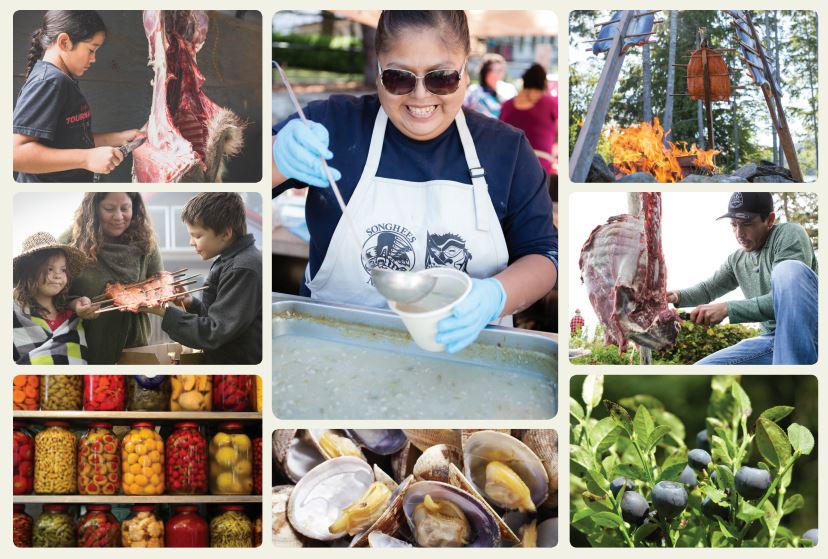Tips to help you prepare your holiday meals and feasts

The holidays are a time for gathering with family, friends and community, and the foods we eat bring people together.
Many First Nations affirm their identities and reinforce their ties to their territories and way of life by harvesting and eating their traditional foods. Traditional foods remain an important aspect of social and cultural events, especially in preparation for and during ceremonies. In this time of giving, we thank the salmon, eulachon, clams, moose, deer, elk, beaver, birds, seaweed, berries, roots and other foods and medicines and they in turn nourish our bodies and spirits and help protect us from illness.
Whether you're roasting a turkey or preparing fresh game, the FNHA has some tips to ensure everybody stays safe and healthy as you share your harvest.
PLAN AHEAD:
If you're choosing to have a turkey this season, is there room in your freezer? And will you have enough time to properly thaw the frozen foods that you'll be serving? To prevent the growth of harmful bacteria, meat needs to be thawed in the fridge (on a tray, and on the lowest shelf so it doesn't drip on ready-to-eat foods), or in the sink in cold water with the wrapper still on. If you thaw in the sink, the water should be changed every thirty minutes. Thawing large items properly takes time - likely a few days!
If you buy a fresh, unfrozen turkey, or will be serving fresh game meat, it should be cooked within three days and kept refrigerated. Your fridge should be at or below 4'C; you can keep a thermometer in your fridge to check this. Make sure that game is kept below 4'C and at room temperature for 2 hours or less during cutting and processing.
KEEP IT CLEAN AND SEPARATE
Holiday meals often involve a lot of steps and a lot of different items. Make sure to wash your hands frequently using warm water and soap, and prevent cross-contamination between raw and cooked food items. Using separate cutting boards for different food items (especially raw meats, poultry, seafood, eggs, and ready-to-eat foods like vegetables) are a great way to make sure contamination doesn't spread. If you only have one cutting board, it should be cleaned using hot water and soap, and sanitized using a bleach solution between raw and ready-to-eat foods. A solution can be quickly made by combining two tablespoons of bleach with a gallon (4.5L) of water. Companies like Lysol and Clorox make ready-to-use sanitizing solutions that can be purchased in most stores. Just make sure to follow manufacturer's instructions, and make sure they're appropriate for food contact surfaces.
Ready-to-eat and raw meat, poultry, seafood, and eggs should be kept separate.
MAKE SURE IT'S COOKED!
Food should be cooked to 74'C to kill disease-causing bacteria. For a turkey, grouse, or other birds, check the thickest part of the breast and the innermost parts of the wings and thighs. For deer, moose, and other meat, make sure to measure at the thickest part. A probe thermometer is an inexpensive way to make sure foods are cooked thoroughly - you can't always tell just by looking!
Salmon, trout, and other fish should be cooked to 63'C, or until the flesh is opaque. Shellfish should be cooked to 90'C for 90 seconds.
OTHER FOOD ITEMS
Meat isn't the only food that can cause illness during the holidays. Pies that are made with milk or eggs should be refrigerated within two hours of cooking too! Fruit pies can be kept at room temperature but should be eaten within two days if they are.
Low acid and high protein foods (e.g. meat, vegetables) must be canned with a pressure canner to prevent botulism. If you're unsure whether a canned product was properly handled, it's better not to take any chances!
DEALING WITH LEFTOVERS
Improper cooling is one of the most common causes of foodborne illness. Leftovers should be split into smaller portions for faster cooling, and placed in the fridge within two hours of cooking.
Have lots of leftovers? Don't keep them around for too long - they should be used within two or three days, and then discarded. If there's too much for you to finish in that time, consider sending some home with friends and family! It's important to remember to keep food cold or hot when it's travelling, and if guests are travelling more than two hours, consider sending them home with lower risk food items like cookies and fruit pies.
Food is part of celebration, ceremony, social functions, learning opportunities and is one of our best ways to bring people together. Have a safe and healthy holiday season!
FNHA RESOURCES:
FNHA has a number of additional resources that can support you and your loved ones in gathering and sharing food in a safe and healthy way.
• Preventing Foodborne Illness (http://www.fnha.ca/WellnessSite/WellnessDocuments/FNHA-Food-Safety-For-First-Nations-Foodborne-Illness-Brochure.pdf)
• Food Safety at Community Events (http://www.fnha.ca/WellnessSite/WellnessDocuments/FNHA-Food-Safety-For-First-Nations-Community-Events-Brochure.pdf)
• Shellfish Safety (BCCDC resource): http://www.bccdc.ca/resource-gallery/Documents/Educational%20Materials/EH/FPS/Fish/ShellfishSafetyPoster_2012.pdf

